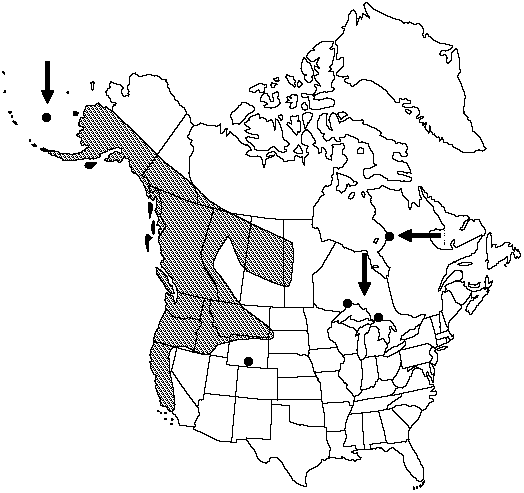FNA>Volume Importer |
FNA>Volume Importer |
| Line 26: |
Line 26: |
| | }}<!-- | | }}<!-- |
| | | | |
| − | --><span class="statement" id="st-d0_s0" data-properties="petiole atypical some measurement;petiole some measurement;base architecture or pubescence"><b>Petiole </b>15–45 (–60) cm, base densely scaly;</span> <span class="statement" id="st-d0_s1" data-properties="scale coloration;scale coloration;scale shape;scale shape;scale atypical length;scale length;scale atypical width;scale width;scale shape">scales brown or dark-brown, lanceolate or ovatelanceolate, (7–) 10–20 × (1–) 2–5 mm, ± crisped.</span> <span class="statement" id="st-d0_s2" data-properties="blade shape;blade shape;blade shape;blade shape;blade length;blade width;blade shape;blade width;apex shape"><b>Blade </b>elliptic to oblanceolate, 1–2-pinnate-pinnatifid, 25–120 × 10–50 cm, gradually narrowed proximally, broadest at or just above middle, apex acuminate.</span> <span class="statement" id="st-d0_s3" data-properties="pinna architecture;pinna architecture;pinna shape;pinna shape;apex shape"><b>Pinnae </b>very short-stalked or sessile, linear-oblong or oblong, apex acuminate.</span> <span class="statement" id="st-d0_s4" data-properties="pinnule architecture;pinnule shape;pinnule shape;base shape;base architecture or shape;base shape;apex shape;apex shape;apex shape"><b>Pinnules </b>sessile, narrowly deltate or oblong-lanceolate, base basiscopically broadly cuneate, acroscopically truncate, ± auriculate, apex obtuse to ± acute.</span> <span class="statement" id="st-d0_s5" data-properties="rachis pubescence;rachis pubescence;costa pubescence;costule pubescence;gland coloration"><b>Rachis,</b> costae, and costules glabrous or with scales or pale glands.</span> <span class="statement" id="st-d0_s6" data-properties="sorus shape;sorus shape;sorus shape;sorus shape;sorus shape;sorus position;sorus position;sorus position"><b>Sori </b>round to elliptic, hooked at distal end, or horseshoe-shaped, medial to supramedial;</span> <span class="statement" id="st-d0_s7" data-properties="indusium architecture or pubescence or shape;indusium length or size;marginal hair architecture;indusium character">indusia long-ciliate with nonglandular marginal hairs as long as or longer than width of indusia.</span> <span class="statement" id="st-d0_s8" data-properties=""><b>Spores </b>yellow.</span> <span class="statement" id="st-d0_s9" data-properties="spore coloration;2n chromosome count">2n = 80.</span><!-- | + | --><span class="statement" id="st-undefined" data-properties=""><b>Petiole </b>15–45(–60) cm, base densely scaly; scales brown or dark brown, lanceolate or ovate-lanceolate, (7–)10–20 × (1–)2–5 mm, ± crisped. <b>Blade</b> elliptic to oblanceolate, 1–2-pinnate-pinnatifid, 25–120 × 10–50 cm, gradually narrowed proximally, broadest at or just above middle, apex acuminate. <b>Pinnae</b> very short-stalked or sessile, linear-oblong or oblong, apex acuminate. <b>Pinnules</b> sessile, narrowly deltate or oblong-lanceolate, base basiscopically broadly cuneate, acroscopically truncate, ± auriculate, apex obtuse to ± acute. <b>Rachis</b>, costae, and costules glabrous or with scales or pale glands. <b>Sori</b> round to elliptic, hooked at distal end, or horseshoe-shaped, medial to supramedial; indusia long-ciliate with nonglandular marginal hairs as long as or longer than width of indusia. <b>Spores</b> yellow. <b>2n</b> = 80.</span><!-- |
| | | | |
| | -->{{Treatment/Body | | -->{{Treatment/Body |
| Line 55: |
Line 55: |
| | |publication year=1845 | | |publication year=1845 |
| | |special status= | | |special status= |
| − | |source xml=https://jpend@bitbucket.org/aafc-mbb/fna-fine-grained-xml.git/src/287ef3db526bd807d435a3c7423ef2df1e951227/V2/V2_87.xml | + | |source xml=https://jpend@bitbucket.org/aafc-mbb/fna-data-curation.git/src/9216fc802291cd3df363fd52122300479582ede7/coarse_grained_fna_xml/V2/V2_87.xml |
| | |genus=Athyrium | | |genus=Athyrium |
| | |species=Athyrium filix-femina | | |species=Athyrium filix-femina |
| | |variety=Athyrium filix-femina var. cyclosorum | | |variety=Athyrium filix-femina var. cyclosorum |
| − | |2n chromosome count=80
| |
| − | |apex shape=obtuse;more or less acute
| |
| − | |base architecture or pubescence=scaly
| |
| − | |base architecture or shape=truncate
| |
| − | |base shape=auriculate;cuneate
| |
| − | |blade length=25cm;120cm
| |
| − | |blade shape=narrowed;1-2-pinnate-pinnatifid;elliptic;oblanceolate
| |
| − | |blade width=broadest;10cm;50cm
| |
| − | |costa pubescence=glabrous
| |
| − | |costule pubescence=glabrous
| |
| − | |gland coloration=pale
| |
| − | |indusium architecture or pubescence or shape=long-ciliate
| |
| − | |indusium character=width
| |
| − | |indusium length or size=longer
| |
| − | |marginal hair architecture=nonglandular
| |
| − | |petiole atypical some measurement=45cm;60cm
| |
| − | |petiole some measurement=15cm;45cm
| |
| − | |pinna architecture=sessile;short-stalked
| |
| − | |pinna shape=oblong;linear-oblong
| |
| − | |pinnule architecture=sessile
| |
| − | |pinnule shape=oblong-lanceolate;deltate
| |
| − | |rachis pubescence=with scales or pale glands;glabrous
| |
| − | |scale atypical length=7mm;10mm
| |
| − | |scale atypical width=1mm;2mm
| |
| − | |scale coloration=dark-brown;brown
| |
| − | |scale length=10mm;20mm
| |
| − | |scale shape=crisped;ovatelanceolate;lanceolate
| |
| − | |scale width=2mm;5mm
| |
| − | |sorus position=medial;supramedial
| |
| − | |sorus shape=horseshoe-shaped;hooked;round;elliptic
| |
| − | |spore coloration=yellow
| |
| | }}<!-- | | }}<!-- |
| | | | |
| | -->[[Category:Treatment]][[Category:Athyrium filix-femina]] | | -->[[Category:Treatment]][[Category:Athyrium filix-femina]] |
Petiole 15–45(–60) cm, base densely scaly; scales brown or dark brown, lanceolate or ovate-lanceolate, (7–)10–20 × (1–)2–5 mm, ± crisped. Blade elliptic to oblanceolate, 1–2-pinnate-pinnatifid, 25–120 × 10–50 cm, gradually narrowed proximally, broadest at or just above middle, apex acuminate. Pinnae very short-stalked or sessile, linear-oblong or oblong, apex acuminate. Pinnules sessile, narrowly deltate or oblong-lanceolate, base basiscopically broadly cuneate, acroscopically truncate, ± auriculate, apex obtuse to ± acute. Rachis, costae, and costules glabrous or with scales or pale glands. Sori round to elliptic, hooked at distal end, or horseshoe-shaped, medial to supramedial; indusia long-ciliate with nonglandular marginal hairs as long as or longer than width of indusia. Spores yellow. 2n = 80.
Habitat: Moist woods, swamps, streambanks
Elevation: 10–1600 m
Distribution
Alta., B.C., Man., N.W.T., Ont., Que., Sask., Yukon, Alaska, Calif., Idaho, Mont., Oreg., S.Dak., Wash., Wyo.
Discussion
Athyrium filix-femina var. cyclosorum is most similar to the European var. filix-femina; it differs in having broader, nearly equilateral pinnules and medial to supramedial sori. The variety is distributed in northwestern North America with disjunct populations in northwestern Quebec and Ontario.
Selected References
None.
